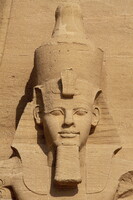| dc.coverage.spatial | Site: Abu Sunbul, Upper Egypt, Egypt | en_US |
| dc.coverage.temporal | ca. 1279-1250 BCE (creation) | en_US |
| dc.creator | unknown (Egyptian (ancient)) | en_US |
| dc.date | -1279--1250 | en_US |
| dc.date.accessioned | 2013-04-12T18:43:11Z | |
| dc.date.available | 2013-04-12T18:43:11Z | |
| dc.date.issued | -1279--1250 | en_US |
| dc.identifier | 208231 | en_US |
| dc.identifier.other | archrefid: 763 | en_US |
| dc.identifier.uri | http://hdl.handle.net/1721.3/116105 | |
| dc.description | Seated statue of Ramesses II, on the viewer's far left, frontal view; Abu Simbel is a site in Egypt, on the west bank of the Nile in Lower Nubia, 280 km south of Aswan. With the construction of the Aswan Dam in the early 1960s, the temple complex was one of a number of ancient monuments saved by being moved to a new site. Having been cut into pieces and reassembled, it now stands on the shores of Lake Nasser, 64 m higher and 180 m west of its ancient site. It was already an ancient sacred site when Ramesses II (reigned ca. 1279-ca. 1213 BCE) chose it for his most grandiose, and most famous, Nubian monument. The construction of the Great and Small Temples of Abu Simbel began in the early years of Ramesses II, and they were completed by around the 25th year of his reign. The terrace of the Great Temple is lined with statues of falcons alternating with statues of the King as Osiris and as living ruler. These statues, although on a large scale, are dwarfed by the rock-cut façade of the temple (30 m high and 35 m long). The whole is dominated by four colossi of Ramesses II, each 22 m high. Over the doorway, in a large rectangular niche, a figure of the King as the hawk-headed god Re-Horakhty emerges. This large image is flanked by smaller figures of the goddess Maat and the 'was' sceptre, thus creating a rebus of the King's throne name, User-maat-Re. It is part of the UNESCO World Heritage Site known as the 'Nubian Monuments', which run from Abu Simbel downriver to Philae (near Aswan). Source: Grove Art Online; http://www.groveart.com/ (accessed 1/15/2008) | en_US |
| dc.format.medium | stone; sandstone | en_US |
| dc.rights | © Scott Gilchrist, Archivision, Inc. | en_US |
| dc.subject | architectural exteriors | en_US |
| dc.subject | deities | en_US |
| dc.subject | rulers and leaders | en_US |
| dc.subject | Ramses II, King of Egypt | en_US |
| dc.subject | New Kingdom (Egyptian) | en_US |
| dc.subject | Nineteenth Dynasty | en_US |
| dc.subject | Ramesside period | en_US |
| dc.title | Great Temple of Abu Simbel | en_US |
| dc.title.alternative | Temple of Re-Horakhty | en_US |
| dc.type | image | en_US |
| dc.rights.access | Licensed for educational and research use by the MIT community only | en_US |
| dc.identifier.vendorcode | 1A3-EG-AS-1-C3 | en_US |
| vra.culturalContext | Egyptian (ancient) | en_US |
| vra.technique | carving (processes) construction (assembling) | en_US |
| vra.worktype | temple | en_US |
| vra.worktype | excavation (site) | en_US |
| dc.contributor.display | unknown (Egyptian (ancient)) | en_US |


